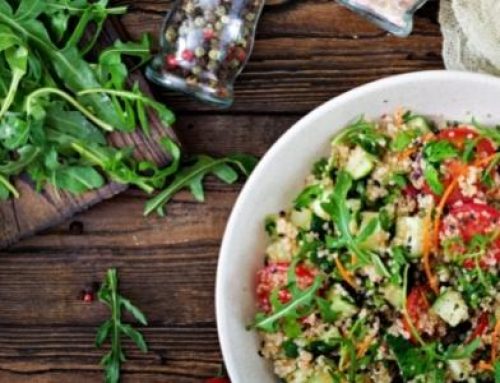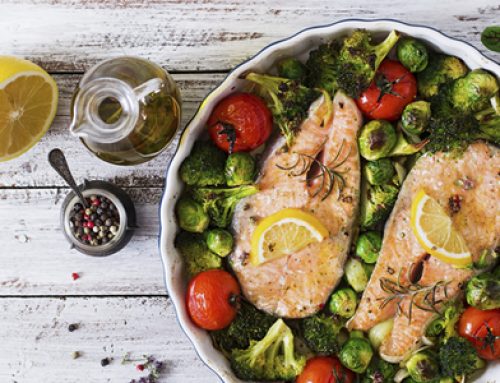 Have you heard of the saying ‘food is thy medicine’? One of the mightiest ways to overcome inflammation and keep your body healthy does not necessarily come from a pharmacy – but from the food we eat.
Have you heard of the saying ‘food is thy medicine’? One of the mightiest ways to overcome inflammation and keep your body healthy does not necessarily come from a pharmacy – but from the food we eat.
What is inflammation?
Inflammation can be acute or chronic.
Acute inflammation is an important response. It sends the artillery (immune cells) to the site of injury to promote healing – for example, when you hit your little toe on the corner of the coffee table.
Chronic inflammation usually evolves when acute inflammation is not resolved. This then leads to an out of proportion response from the artillery, causing potential damage to the body – for example, rheumatoid arthritis of the little toe joint.
Many scientific studies have shown diets high in saturated fat, sugar and salt are the main contributors to chronic disease and inflammation, some of which include: cardiovascular disease, type two diabetes, some cancers, arthritis, Alzheimers, dementia and depression.
In a nutshell, following an ‘anti-inflammatory diet’ is all about healthy eating. It’s about eating a good variety of fruits, vegetables, whole-grains, plant-based proteins (e.g. legumes and nuts) and oily fish (e.g. salmon, sardines). Don’t get bogged down about single ‘superfoods’ to flight inflammation (aka. turmeric) – think big! Think whole foods!
Here are some tips to help include more whole foods into your diet to help fight inflammation:
Tip One: Base your diet around whole-foods
I know it’s easy to do a google search on ‘what are the best anti-inflammatory foods?’ – but you’ll be bombarded with conflicting ‘anti-inflammatory diets and meal plans’.
My advice: Keep it simple. Don’t stress about which whole foods are ‘better’, because that can easily lead towards a path of less variety. Instead, try and focus on basing your diet around choosing fresh whole foods first. This includes a diet rich in different colours of fruits and vegetables.
Tip two: Mix it up with protein
Finding that you are stuck with the same meat and 3-veg dinner meals each night? If you said yes, well it’s time to mix things up. Frequently eating large portions of red meat has been linked to some cancers and obesity. Incorporating planned vegetarian nights or seafood nights into your week is a good way to increase omega-3 fatty intake (‘good fats’). Omega-3 has been linked to reducing inflammation.
So why not mix it up by incorporating different protein sources? An example week may look like:
Monday – Vegetarian Pad Thai
Tuesday – Zesty Lamb and Grilled Vegetables
Wednesday – Cashew and Vegetable Stir Fry
Thursday – Fish with Tomato and Feta Salsa
Friday – Chicken and White Bean Parcels
Tip three: Think about fat
Confused about which oil is the ‘best’? There are so many different oils, butters and margarines on the market, all with different added components. Read here, for why you shouldn’t be fearful of fat.
Back to the philosophy of keeping it simple: research has shown ‘good’ fats (aka: monounsaturated and polyunsaturated) help reduce inflammation, whereas ‘bad fats’ (aka: saturated and trans) do not. So why not try and aim to prioritise and incorporate healthy fats into your diet?
Good sources of healthy fats may include: extra virgin olive oil, vegetable oils, nuts and seeds, avocado, oily fish and plant based margarines.
Recipe ideas
Stuffed Capsicum with Mediterranean Inspired Cauliflower Rice

Ingredients (serves 2)
- 250g butternut pumpkin, cut into cubes
- 2 capsicums, washed, tops cut off and seeds removed
- 2 tbsp. olive oil
- 2 tbsp. Italian herbs
- 130g cauliflower rice (use wholemeal couscous as alternative)
- 200g 4 bean mix
- 200g corn kernels
- 300ml passata
- 1 cup spinach, roughly chopped
- ½ cup shredded cheese
- 1/3 cup parsley, roughly chopped
Method
- Preheat oven to 180 degrees. In a baking tray coat pumpkin with olive oil and Italian herbs and bake for 10 minutes or until soft.
- Remove pumpkin from tray. To the same tray, add in the capsicums. Bake for 5 minutes and remove.
- Meanwhile, in a large bowl add the cauliflower rice, bean mix, corn kernels, roasted pumpkin, parsley and passata. Combine mixture until thoroughly combined.
- Fill each capsicum with the Mediterranean mix and top with cheese.
- Bake for another 10 minutes or until cheese is melted.
- Serve and enjoy!
Mexican Lettuce Burritos

Ingredients (serve 2)
- 1 tbsp. garlic paste
- 1 tbsp. olive oil
- 4 tomatoes, roughly chopped
- 1 zucchini, diced
- 1 capsicum, diced
- 200g 4 bean mix, washed and drained
- 200g corn kernels, washed and drained
- ½ bunch fresh parsley, roughly chopped
- 6 ice-burg lettuce leaves, washed
- 1 cup shredded cheese
- 1 cup Greek yoghurt
Method
- Heat oil in a large saucepan, add garlic and tomatoes. Cook for 5-6 minutes or until tomatoes become soft.
- Crush tomatoes and add zucchini. Leave to simmer for 5 minutes.
- Add in parsley, capsicum, bean mix and corn. Leave to simmer for another 5 minutes. Remove from heat.
- Carefully remove lettuce leaves from the lettuce bunch and set aside. In each lettuce leaf, place a heaped spoonful of the Mexican mix, sprinkle cheese over the top and add a dollop of greek yoghurt in the centre.
- To wrap: fold the bottom up first, followed by each side.
- Serve and enjoy!
If you’d like further help with your nutrition please click below:
References:
O’Keefe, J.H, Gheewala, N.M & O’Keefe J, ‘Dietary Strategies for Improving Post-Prandial Glucose, Lipids, Inflammation, and Cardiovascular Health’, Journal of the American College of Cardiology,51(3):22, 249-255
Alemany, A, Barbera, R, Alegria, A & Laparra, J.M, ‘Plant sterols from foods in inflammation and the risk of cardiovascular disease: A real threat?, Food and Chemical Toxicology, 2014, 69:140-149





